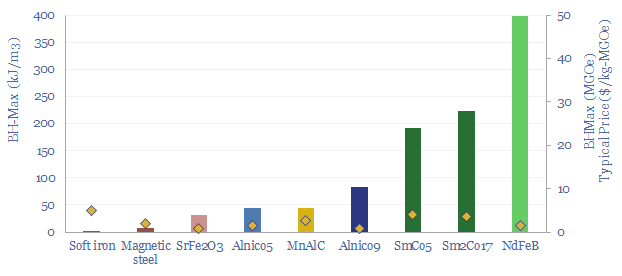Electric currents create magnetic fields. Moving magnets induce electric currents. These principles underpin 95% of global electricity. Plus 50% of wind turbines and over 90% of electric vehicles use permanent magnets with Rare Earth metals. This 15-page overview of magnets covers key concepts and controversies for the energy transition.
What is a magnet? There are 650-page textbooks seeking to answer this question. Our goal in this research note is to distil all of the key concepts for magnets in the energy transition, into just 15 highly concise pages, and starting from first principles.
A magnet is a source of potential energy with potential to exert forces on moving charges. We explain the key formulae for magnetic forces on pages 2-3, covering magnetic fields (m3), magnetic flux (Webers) and magnetic flux density (Teslas).
Magnets are the basis for all electric motors and over 95% of today’s global electricity generation, via moving magnets in rotors and magnetic induction in stator arrays. Even basic units of energy, electricity and thermodynamics tie to magnetic units (pages 4-6).
Magnetic properties that matter most for practical applications are remanent magnetic flux density (Teslas), coercivity (kA/m) and maximum energy product (J/m3, or Mega-Gauss Oersteds (MGOe)). We explain these variables, and why they matter on page 7.
Electromagnets are widely used in stationary power generation and large motors, using soft metals with low coercivity and low remanent flux densities. We cover the key materials, advantages and disadvantages on page 8.
Permanent magnets using different Rare Earth materials are compared and contrasted. Their properties hinge on quantum physics. Which sounds Academic. But it is important to understand why NdFeB will be hard to displace. And we promise that pages 9-10 are surprisingly readable, despite venturing into the murky quantum realm.
Global electricity will surpass 30,000 TWH for the first time in 2023, and the CAGR for global electricity demand steps up from 2% pa to 4% pa in the energy transition. Substantively all electricity in the world is produced by magnets, and the remainder is produced by semiconductor. Implications for magnets, and vice versa, are discussed on page 11.
Wind power uses a balance of electromagnets in doubly fed induction generators and increasingly, permanent magnets. Our key conclusions on the relative merits are on page 12.
Electric vehicle sales need to ramp up by another 20x in our roadmap to net zero. A key debate, pace Tesla, is whether efficient and long-range electric vehicles will need to continue using Rare Earth magnets containing neodymium, dysprosium, terbium, praseodymium (page 13).
Leading companies in permanent magnet value chains include recent acquisitions from large private equity firms, listed Asian pure plays, and industrial conglomerates. We have summarized some of these companies and recent industry trends on pages 14-15.
